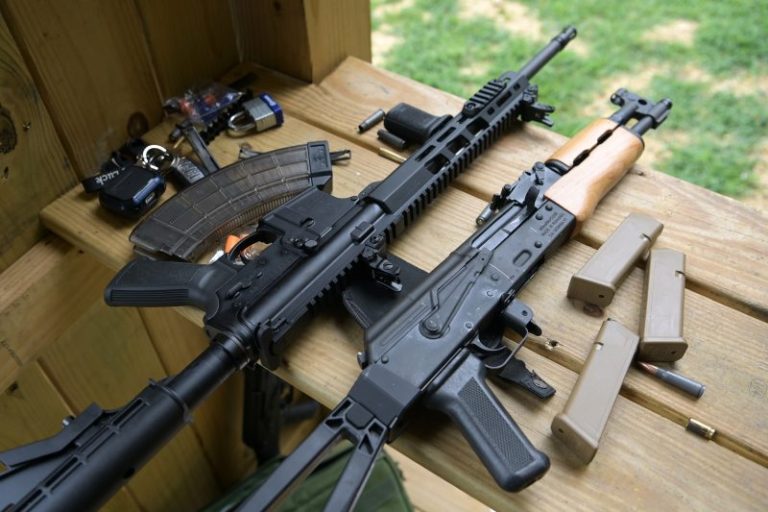A Maryland ban on semiautomatic rifles with military-style features is unconstitutional in light of recent Supreme Court precedent because the firearms are owned by millions of Americans, gun advocates are arguing in federal court.
“If a firearm is in common use today, it cannot be banned,” a group of Marylanders and national gun rights groups said in a filing before oral argument Tuesday in the U.S. Court of Appeals for the 4th Circuit. “The rifles banned by Maryland are among the most popular firearms in the country.”
Maryland’s prohibition on “assault weapons” was passed in the wake of the 2012 massacre of 20 children and six adults at an elementary school in Newtown, Conn. The state banned less-common semiautomatic “assault pistols” in 1994. The laws cover some but not all semiautomatic rifles, including any that hold more than 10 rounds of ammunition or are less than 29 inches long. Rifles compatible with detachable magazines cannot have both a folding stock and a flash suppressor or grenade launcher, according to the law.
The lead plaintiff in the case, a Baltimore paramedic, said in court filings that he would like to carry a Desert Tech MDRX rifle, described by its manufacturer as “built to survive the harshest military conditions.” The gun carries only 10 rounds but is covered by the ban because of its relatively small size.
Maryland’s restrictions were upheld by the 4th Circuit in 2017, but that precedent is in doubt after a Supreme Court ruling this year striking down New York’s requirement of “proper cause” to carry a concealed handgun. Similar permitting systems in six states, including Maryland, are now in legal jeopardy.
Attorneys for the plaintiffs argued that the Supreme Court has now made clear “the only historically acceptable (which is also to say the only constitutionally acceptable) justification for banning types of arms is that they are both ‘dangerous and unusual.’”
“Law-abiding citizens have a right to use firearms that are in common use today,” Peter A. Patterson said Tuesday in representing the gun advocates.
The “dangerous and unusual” language comes from a 2008 Supreme Court ruling striking down a D.C. ban on all handguns. That decision established an individual right to bear arms but deemed many existing regulations on firearms “presumptively lawful.” This year, the court ruled that such restrictions are presumed unconstitutional unless proven “consistent with this Nation’s historical tradition of firearm regulation.”
The only such regulations the court identified outlawing specific types of firearms are Colonial-era bans on “dangerous and unusual” weapons that “caused fear or terror.”
And semiautomatic rifles are incredibly popular among gun buyers. A 2021 survey estimates that about 30 percent of gun owners have owned an AR-15 or similar rifle; more than half have owned a gun that carries more than 10 rounds. There are nearly 25 million semiautomatic rifles in circulation, according to a firearm trade association.
Judge Paul V. Niemeyer, who would have struck down Maryland’s law as unconstitutional five years ago, said at oral argument the 4th Circuit’s reasoning was now “inconsistent” with Supreme Court precedent.
“Weapons generally begin in the military and gravitate or migrate to the civilian population,” he said. “The determinant is … whether it’s in common use.”
Judge Stephanie Thacker, who joined the majority in the 2017 case, questioned whether there was any limit to that test. “If firearms dealers flooded the market with grenade launchers or nuclear weapons, and everybody wanted to buy them to protect themselves, that would then be in common use for a lawful purpose?” she asked.
“The Supreme Court has said, ‘We trust the American people,’” Patterson replied.
The plaintiffs also argue that semiautomatic weapons are not especially dangerous given that most murders are committed with handguns. Research indicates that bans on large-capacity magazines reduce gun deaths; the plaintiffs are not contesting Maryland’s ban on magazines that hold more than 10 rounds of ammunition.
Maryland counters that the banned firearms are “novel weapons that pose heightened dangers to public safety.” It “remains an open question” which guns are “dangerous and unusual” under the latest Supreme Court ruling, Maryland Assistant Attorney General Robert Scott said in oral argument.
“That is a limitation” on gun rights, Scott said.
If the court is not persuaded, the state wants a chance to probe how common and useful these guns truly are, saying the plaintiffs are relying on a handful of surveys and anecdotes. “We dispute that these weapons are in common use for self-defense,” Scott said.
Democrats have renewed discussion of a national assault weapons ban in the wake of a shooting at a Colorado LGBTQ club where five people were killed and 18 wounded. A ban enacted under President Bill Clinton in 1994 expired under George W. Bush in 2004.

